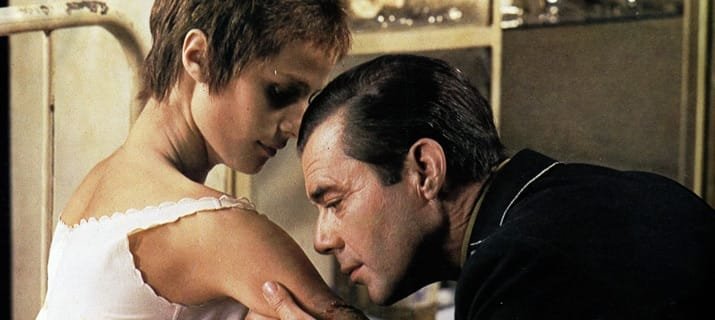
By Helen Creighton
1974’s Il Portiere di Notte, aka The Night Porter, is a film that uneasily straddles the line between art house movie and outright Nazisploitation flick. It deals with the post-war meeting and subsequent doomed relationship between a young female concentration camp survivor, Lucia (Charlotte Rampling) and the oddball, sadistic SS officer Max (Dirk Bogarde) who both sexually abused and protected her there. Post-war, Bogarde’s character hides in the shadows of Vienna as a night-shift hotel clerk, consumed by shame and consorting with a motley crew of ex-Nazis and collaborators who hold regular mock trials where they cynically rehearse their contrition and defence, whilst colluding in the destruction of evidence and the murder of any witnesses to their wartime atrocities. Lucia, haunted by her past to the point she reignites her twisted sexual relationship with Max after a chance meeting, is just such a witness. On release in 1974, the film met with almost universal critical distaste and to this day has the ability to trouble and perturb both critics and audience with its refusal to refer to straightforward Holocaust victim narratives, its incongruous display of eroticism within the confines of a death camp and its exploration of complicity as a component of survival under extreme circumstances. Too slow and serious for a standard exploitation film audience, too explicit and shocking a subject matter for the arthouse crew, it seems likely to forever remain a cult film.
Italian director and screenwriter Liliana Cavani cites a chance meeting with a female survivor of the Nazi death camps as the inspiration for the film. She noted a woman laying flowers at the site of an infamous camp. She spoke with her and learned she was a survivor of the camp, assuming the flowers were for a murdered family member or comrade. Not so. The woman spoke of her lover, a German officer. Cavani’s shock and subsequent curiosity concerning the occurrence of such seemingly bizarre relationships (that did indeed occur – in cases such as Katya Singer, who parleyed her own notorious beauty into a book-keeping position in Auschwitz-Birkenau, an SS officer lover and the ability to save many lives) informed her writing of the screenplay. The film is clearly also informed by the complex European political situation post-war, where Cold War concerns reigned supreme, but the spectre of fascism was still alive and well and living quietly in society’s closets. Italy had just suffered what are referred to as the ‘Years of Lead’, characterized by far-right terrorist activity rumoured to be sponsored by anti-communist, Nato-led Operation Gladio. Not only had many Nazi war criminals simply disappeared into the night (and over to South America and the Middle East etc.) in 1945 and beyond, remaining forever unaccountable for their crimes against humanity, many more had been officially ‘denazified’ and remained in the top tiers of society, politics and business. Hidden in plain sight, rich and successful, their pasts unspoken of, such circumstances eventually inspired far-left German terror group Red Army Faction to explode in a orgy of violence and murder of their own. The Night Porter’s gang of Nazi reprobates living in the shadows in Vienna, secretly rehearsing their own self-defenses and clearing their consciences doesn’t seem that far-fetched, in light of this.
However, beyond the endlessly discomfiting narrative, beyond the politics, beyond the ambiguities of sado-masochistic relationships, beyond Rampling’s fierce, blue-eyed, outraged gaze, Bogarde’s perfectly-pitched, fury-laced descent into obsession and and their characters’ disturbing, joint regression into their pasts, it is Cavani’s startling, iconic visuals that remain in the mind’s eye and which have subsequently infiltrated the mainstream and informed many a subculture. Lucia’s semi-nudity combined with her deconstructed SS uniform and cap remains a standard erotic fashion reference from catwalk couture to your average S&M club. Any single frame of the sequence set in the louche Nazi officers’ mess, replete with accordion-playing,Venetian-masked SS officers, where young Lucia sings for her life may as well function as a precise snapshot of influential and controversial neofolk band Death in June’s entire aesthetic. I’ve seen that outfit referenced in everything from random episodes of the 90s TV espionage series La Femme Nikita to the covers of mainstream women’s magazines. Lady Gaga’s video for the song ‘Alejandro’ owes a great unspoken debt to The Night Porter’s aesthetic sensibilities and themes, while Lucia’s eroticized SS gear pops up as one of many casual outfit changes in her video for her hit ‘Love Game’. As recently as 2011, designer Louis Vuitton’s collection clearly referenced the film. For a film which posits that the present is forever haunted and indeed deformed by the unacknowledged spectres of the past, this seems a fitting legacy.
